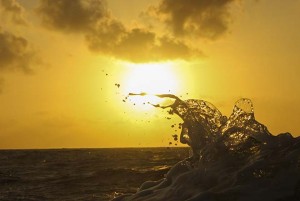 Welcome to our blog for the Plastic in the Pacific Crusade. If you missed the earlier editions please go to category file in the footer to go back and read them. They are listed under Plastic in the Pacific. Over the coming year we will be writing regularly of our adventures and what we are seeing. In this article we sail to the Tuamotu Atolls.
Welcome to our blog for the Plastic in the Pacific Crusade. If you missed the earlier editions please go to category file in the footer to go back and read them. They are listed under Plastic in the Pacific. Over the coming year we will be writing regularly of our adventures and what we are seeing. In this article we sail to the Tuamotu Atolls.
As mentioned in my previous blog, the Tuamotu’s were THE place I was most looking forward to exploring on this trip. Located between the Marquesas Islands and the Society Islands (Tahiti and Bora Bora etc), these atolls stick up out of 1500m of water and most of them are literally a rim around a crater which on most islands has a maximum width of around 200m of land.
The wind forecast for our trip down to our first atoll was for 12-18 knots beam reaching all the way. A perfect run and initially we had no real definite of which atoll we would go to. We would head towards Fakarava way and see what the weather brought and plan our days as we went. So off we headed at 1430 on a Wednesday afternoon and the first day would be 12-14 knots. As we passes Ua Pau, the island south of Nuku Hiva, we tried to give it a wide berth so we didn’t end up in a wind shadow. It would have been nice to have time to visit this little island but time restrictions and the desire to spend more time in the Tuamotu’s meant we passed it by at a distance. Even at 10nm west of the island we still felt the effects of the island briefly around night fall but soon it would pass and we would have smooth sailing into the evening.
The early morning brought lighter winds and it would switch all over the place. We had rain squalls and I was getting increasingly frustrated that the winds were not what was forecast. I’m pretty easy to please at sea, give me 15-20 knots from between 90 – 140 degrees from our destination, sunny skies and smooth seas and I’ll be happy as Larry. When the winds are everything but and the yacht is rolling uncomfortably and the sails are flapping, then I get frustrated. Eventually I must have yelled loud enough as we had set the spinnaker and less than an hour later I am yelling at Annika saying we have to pull it down as the wind was coming in. And it came in quick. As soon as the sock was down, the wind was already at 16-18 knots beam reaching. Once on deck and packed away, we actually ended up reefing the main a little to balance the boat.
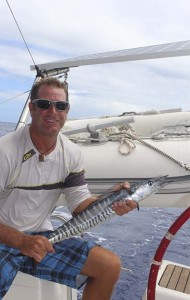 For the next two days we would sail at this beautiful angle, firing along at 7-8 knots. To top it off our first Spanish Mackeral of the trip came aboard. He wasn’t the biggest but three good meals for Annika and I. We love this fish. So good fresh out of the ocean. We managed to complete 130nm in the first 24 hours and then 2 x 170nm days which were our best since departing Croatia. Our destination became Aratika Atoll, one of the smaller ones with a caution on our cruising guide that the passes into the atoll are challenging for the experienced and not recommended for the less experienced sailor. The atoll had been recommended by Kevin on Nuku Hiva.
For the next two days we would sail at this beautiful angle, firing along at 7-8 knots. To top it off our first Spanish Mackeral of the trip came aboard. He wasn’t the biggest but three good meals for Annika and I. We love this fish. So good fresh out of the ocean. We managed to complete 130nm in the first 24 hours and then 2 x 170nm days which were our best since departing Croatia. Our destination became Aratika Atoll, one of the smaller ones with a caution on our cruising guide that the passes into the atoll are challenging for the experienced and not recommended for the less experienced sailor. The atoll had been recommended by Kevin on Nuku Hiva.
Of course our usual issue was arriving at night, however we were sailing at such good speeds we could actually make it before night fall. It really would make no real difference as the pass needed to be transited at slack tide and that would mean in the morning at 10am. Hence we would be anchoring behind the atoll close to the entrance either way. As the sun got lower in the sky we would be just 5nm from our anchorage when darkness fell. Close, but no close enough. There were a few navigation lights we could see, including some in the pass, and a few house lights but it was quite barren.
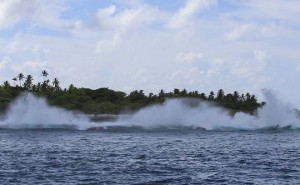 We anchored in a position just south of the entrance in 8m of water and the wind blew us off the reef all night. We could hear and see the waves crashing on the reef all night so initially we set an anchor watch but after 3 hours of this we both found bed too enticing. I set the anchor watch alarm on Maxsea instead. Our anchorage here was probably the smoothest anchorage we had been in for a very long time. Come morning and we realised that I had made a big mistake. This campaign should not be called Plastic in the Pacific, it should have been Plastic in Paradise!!!
We anchored in a position just south of the entrance in 8m of water and the wind blew us off the reef all night. We could hear and see the waves crashing on the reef all night so initially we set an anchor watch but after 3 hours of this we both found bed too enticing. I set the anchor watch alarm on Maxsea instead. Our anchorage here was probably the smoothest anchorage we had been in for a very long time. Come morning and we realised that I had made a big mistake. This campaign should not be called Plastic in the Pacific, it should have been Plastic in Paradise!!!
The waters were insanely clear and that blue of the deep ocean was right here on the reef. On the land were palm trees waving in the wind and white corally beaches. It was majestic to say the least. The pass had about 6-8 knots of water rushing out of it as it was an outgoing tide. They say in 15-20 knots that the two passes on Arataki flow out all day. There was no way of getting in on this current, but we knew that by 1000, an hour after low tide, that we should have a better idea. So we decided to go for a snorkel. What a feast for our eyes. Schools of fish everywhere, pristine head coral reef and 40-50m visibility greeted us. It was perfect. We couldn’t really leave the boat as the current was swirling around us but it gave us an idea of what to expect in the atolls.
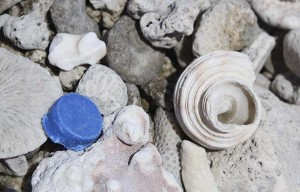 At 0950 we heaved our anchor and made our way in. We had 4-5 knots of current against us and the pass is about 25m wide. It wasn’t too hard, although the old ticker was pumping pretty good initially. As we got further in the water smoothed out and Annika on the bow just kept turning around with a huge smile on her face. She could see the bottom clearly, especially when we had 2.5m clearance underneath us. We entered the atoll safely and made our way half way along the north edge to the main town. There was a large dock but we anchored off and made our way in. Being a Sunday, it was deserted. In fact over the coming days we would hardly see anyone anywhere. As we pulled the dinghy up to the dock, there was rubbish everywhere. It seemed this atoll needed a kick in the butt as they were not handling their rubbish at all well. This is one of the biggest issues we believe we will find on this trip. We are providing so many items in plastic these days, to places that don’t have the facilities to destroy them, that a lot of it is just entering the environment. Plastic in Paradise was really ringing true.
At 0950 we heaved our anchor and made our way in. We had 4-5 knots of current against us and the pass is about 25m wide. It wasn’t too hard, although the old ticker was pumping pretty good initially. As we got further in the water smoothed out and Annika on the bow just kept turning around with a huge smile on her face. She could see the bottom clearly, especially when we had 2.5m clearance underneath us. We entered the atoll safely and made our way half way along the north edge to the main town. There was a large dock but we anchored off and made our way in. Being a Sunday, it was deserted. In fact over the coming days we would hardly see anyone anywhere. As we pulled the dinghy up to the dock, there was rubbish everywhere. It seemed this atoll needed a kick in the butt as they were not handling their rubbish at all well. This is one of the biggest issues we believe we will find on this trip. We are providing so many items in plastic these days, to places that don’t have the facilities to destroy them, that a lot of it is just entering the environment. Plastic in Paradise was really ringing true.
We went over to the surf side and here we found more debris washed up on the broken coral beach. Water bottles and their caps were everywhere. The problem was that all of it was photo-degraded. If you tried to pick it up, you had to be so careful as it would break apart in your hands. The other main item we started finding was ropes and those Chinese round fishing buoys made of solid plastic. We picked up a bit but headed back for the boat soon after as we wanted to find a nice little piece of paradise for the night. Back on the boat and we chose a little island out in the middle of the atoll called Motu Takutua. We steamed over there and dropped anchor off the back of the island. It is not a big island being only 20m x 15m at best but the reef around it stretched out about 150-200m giving very good protection from the easterly winds. As soon as the anchor was set, a little black tip reef shark swims past, then another and before you know it there are 5 of them swimming around the boat. Some people would think this scary, Annika and I were smiling from ear to ear.
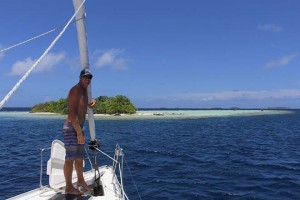 After lunch we had an explore on the island before we snorkeled on top of the reef. It was beautiful and more reef sharks swam around, several 1ft sharks in the shallows were rather cute too. Plenty of fish life and the corals were pretty good with lots of Christmas tree worms and boring clams. When I say boring, I don’t mean mundane, I mean they bore into the hard corals. They are all sorts of colors and between these and the worms, we knew the reef was healthy. Back on the boat and we made some water, and pumped our dive tanks ready for the next day. We would dive the whole motu. At sunset another attraction appeared. Appearing from over the horizon came a few blue beaked, red footed boobie birds. Slowly the numbers built and they would soar over the little motu whilst waiting for others. It was incredible to watch so many appear. There must have been 50-100 of them by the time it got dark and then they all went and landed on the motu together.
After lunch we had an explore on the island before we snorkeled on top of the reef. It was beautiful and more reef sharks swam around, several 1ft sharks in the shallows were rather cute too. Plenty of fish life and the corals were pretty good with lots of Christmas tree worms and boring clams. When I say boring, I don’t mean mundane, I mean they bore into the hard corals. They are all sorts of colors and between these and the worms, we knew the reef was healthy. Back on the boat and we made some water, and pumped our dive tanks ready for the next day. We would dive the whole motu. At sunset another attraction appeared. Appearing from over the horizon came a few blue beaked, red footed boobie birds. Slowly the numbers built and they would soar over the little motu whilst waiting for others. It was incredible to watch so many appear. There must have been 50-100 of them by the time it got dark and then they all went and landed on the motu together.
Morning came and we thought we had run aground. It was so calm, even though the wind was blowing 12-15 knots still. We got our dive gear together after breakfast and headed off in the dinghy. We would tow the dinghy along with us while diving for safety. Without a surface watch, this is the best way to make sure you can do drift dives. We steamed up to the windward end of the reef and dived the SW side. We initially went down to 20m but the best stuff was up at 10m or less. We would dive for 85 minutes and at the end Annika didn’t want to come up. She was happy snapping away at the reef sharks that frequented us, the floury cod that simply sat there and wondered what we were. In fact one particular cod came out and was looking at the strobes on Annika’s camera. It was new to them. Everything was so curious. The locals later said it was probably because they’d never seen white people!!!
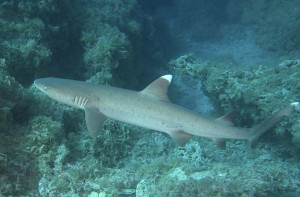 We had lunch and dived in again but this time we anchored the dinghy and swam around onto the windward side. Being the windward side we could not take the dinghy as it would blow back onto the reef. The reef wasn’t as good around this side however there were lots of sharks. One kept swimming between Annika and I as though it was trying to work out what we were. He even swam at the GoPro thinking it might be worth eating. Back around on the sheltered side it was simply stunning. So many small fish and now with dive gear we could get good footage of the Christmas tree worms and clams. Another 80 minute dive later and we were back on the boat, but only to change batteries and then we went and snorkeled the shallows with our cameras. Still the reef sharks came, we loved it.
We had lunch and dived in again but this time we anchored the dinghy and swam around onto the windward side. Being the windward side we could not take the dinghy as it would blow back onto the reef. The reef wasn’t as good around this side however there were lots of sharks. One kept swimming between Annika and I as though it was trying to work out what we were. He even swam at the GoPro thinking it might be worth eating. Back around on the sheltered side it was simply stunning. So many small fish and now with dive gear we could get good footage of the Christmas tree worms and clams. Another 80 minute dive later and we were back on the boat, but only to change batteries and then we went and snorkeled the shallows with our cameras. Still the reef sharks came, we loved it.
The following morning and Annika woke up and as I looked over I wondered what was wrong. She was very sad as all night she had pain in her right ear. She had some minor issues in the Galapagos but something had gone wrong with the dives the day prior and she was very upset that she wouldn’t be able to dive. We searched our first aid kit and got her straight into some antibiotics. We would have to stay out of the water until she was right. It wasn’t the best but we would make the best of a bad situation. Afterall there was plenty to explore on the land still.
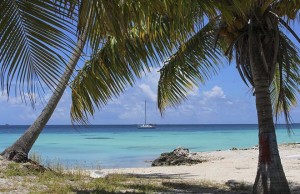 We steamed over to the eastern rim of the atoll and found a deserted island but it had a big sign ‘TABU’ on it. Didn’t need a translator for that one. We went to the next island south of it and it had an abandoned fishing hut on it. We anchored in azure waters that were 15m deep and sat in awe at the beauty of this place. Palm trees reaching for the sky, white sandy beaches and the colors of the water were what everyone dreams off. It really was paradise. After lunch we went for an explore on the island and did our usual ‘Keen to Clean’ pickup of rubbish. There wasn’t a lot on the reef on the windward side like I expected, however it was pretty harsh and a lot would have been disintegrated on the rocks. We did however find a monitoring buoy washed up with a broken aerial.
We steamed over to the eastern rim of the atoll and found a deserted island but it had a big sign ‘TABU’ on it. Didn’t need a translator for that one. We went to the next island south of it and it had an abandoned fishing hut on it. We anchored in azure waters that were 15m deep and sat in awe at the beauty of this place. Palm trees reaching for the sky, white sandy beaches and the colors of the water were what everyone dreams off. It really was paradise. After lunch we went for an explore on the island and did our usual ‘Keen to Clean’ pickup of rubbish. There wasn’t a lot on the reef on the windward side like I expected, however it was pretty harsh and a lot would have been disintegrated on the rocks. We did however find a monitoring buoy washed up with a broken aerial.
Back around the fishing hut and it was a mess. These islanders can’t blame others for the mess, they create a fair bit themselves. There was a pile of old outboards in bits, lots of nets and then this black plastic material would up in 7cm round lines. This is what they grew the pearl shells on. So much plastic to grow something for us. It was crazy. Broken fishing balls, plastic bottles, broken glass, it all littered the area. We even found their dump where they had been burning everything. Yes, that’s right, on this island they burn everything, even the plastic, sending toxic fumes into the air. Where did you think it would go? There is nowhere to bury it on this island and they don’t take it away. Whilst it was a mess, it really was a piece of paradise and I started to think of how cool it would be to build a house there and have cruising yachties come and visit and we could sell local arts etc. We both thought we could settle here quite easily.
That afternoon I pulled apart the monitoring buoy. It had a little chipboard in it attached to a large battery and then three different sensors. We will find out what it was when we get to better internet. However our best guess is it was a current and wave monitoring device. It was built in Florida so we will get to the bottom of it sooner or later.
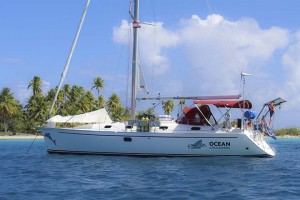 With Annika’s ear not going so well we thought we should move to another atoll called Fakarava in the next day or two to see a doctor and get a better opinion. We spent the next day skirting the north east coast. We anchored near the east pass and this was crazy. With onshore winds of 15 knots there is no way anyone sane would try this pass. The water was rushing out at great speed and standing waves appeared most of the way along it and a long way out to sea. The scenery was amazing. Back in the main town we spoke to a couple of locals and found out that the eye sore of a white building here, a two storey modern concrete building that looked totally out of place, was actually the cyclone bunker. We spoke of the plastic issue and they agreed that everyone needed more educating. Unfortunately we got to the school too late and no one was there.
With Annika’s ear not going so well we thought we should move to another atoll called Fakarava in the next day or two to see a doctor and get a better opinion. We spent the next day skirting the north east coast. We anchored near the east pass and this was crazy. With onshore winds of 15 knots there is no way anyone sane would try this pass. The water was rushing out at great speed and standing waves appeared most of the way along it and a long way out to sea. The scenery was amazing. Back in the main town we spoke to a couple of locals and found out that the eye sore of a white building here, a two storey modern concrete building that looked totally out of place, was actually the cyclone bunker. We spoke of the plastic issue and they agreed that everyone needed more educating. Unfortunately we got to the school too late and no one was there.
We anchored a couple of miles from the west pass that night so we could get to it at first light the next morning. We had to go out just before high tide and that was 0615, 30 minutes after sunrise. We really wished we could have spent more time here but Annika’s ear was playing up too much and her health was paramount so the next day we would set sail down to Fakarava, a larger atoll just 40nm away. Exiting the pass was easy at the right tide with just 1 knot outbound. Even in the early light, you could see everything. Annika drove us out and I sat on the bow this time. What a magic little place this is. For anyone who can make it here, it is highly recommended. There is an airport and 1 little resort you can stay at. Don’t expect anything flash, this is a fairly untouched piece of paradise, but if you want somewhere to get away from it all, then this is the place.
In out next edition we sail to Fakarava Atoll.
Ocean Crusaders are out to change the way people treat our oceans. Our online education program is free to download at www.OceanCrusaders.org/education where children can learn of the issues our oceans are facing and how they can make a difference. The Plastic in the Pacific Crusade is about educating the South Pacific Islands, finding out what is happening in these islands and updating our programs. You can join us in the Pacific and see for yourself what we do.
Ocean Crusaders Plastic in the Pacific Crusade is proudly supported by: Cressi Dive Gear, Gill Marine, Keen Footwear Australia, Barz Optics Sunglasses, Maxsea Navigation Software, Digital Diver Cairns, LED Dive Lights Australia, Boat Names Australia, Predictwind Weather & Sail-world.com
[cincopa A0KAMTNLRrdT]
SIGN UP FOR OUR BLOGS